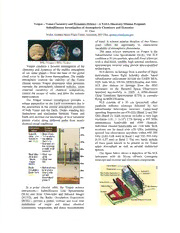
NASA Technical Reports Server (NTRS) 20110013274: Vesper - Venus Chemistry and Dynamics Orbiter - A NASA Discovery Mission Proposal: Submillimeter Investigation of Atmospheric Chemistry and Dynamics PDF
Preview NASA Technical Reports Server (NTRS) 20110013274: Vesper - Venus Chemistry and Dynamics Orbiter - A NASA Discovery Mission Proposal: Submillimeter Investigation of Atmospheric Chemistry and Dynamics
Vesper - Venus Chemistry and Dynamics Orbiter -A NASA Discovery Mission Proposal: Submillimeter Investigation of Atmospheric Chemistry and Dynamics G. Chin NASA Goddard Space Flight Center, Greenbelt, MD USA, [email protected] of wind. A science mission duration of two Venus years offers the opportunity to characterize variability of atmospheric phenomena. The main science instrument on Vesper is the Submillimeter Line Spectrometer (SLS). The SLS combines a 50 cm aperture, spaccraft fixed telescope with a dual-band, tunable, high spectral resolution, \\:h)" \' C'IUC."I'- spectroscopic receiver using proven space-qualified Vesper conducts a focused investigation of the technologies. chemistry and dynamics of the middle atmosphere SLS derives its heritage from a number of flight of our sister planet- from the base of the global instruments. Space flight Schottky diode- based cloud cover to the lower thermosphere. The middle submillimeter radiometers include the UARS MLS atmosphere controls the stability of the Venus EOS Aura MLS, SW AS, MIRO/Rosetta, and Odin: climate system. Vesper determines what processes SLS also derives its heritage from the HIFI maintain the atmospheric chemical stability, cause instrument on the Herschel Space Observatory observed variability of chemical composition, launched successfully in 2009. A 4096-channel control the escape of water, and drive the extreme Chirp Transform Spectrometer (CTS) is currently super-rotation. flying on MIROlRosetta. The Vesper science investigation provides a SLS consists of a 50 cm (projected) offset unique perspective on the Earth environment due to parabolic reflector telescope followed by two the similarities in the middle atmosphere processes submillimeter heterodyne receivers. Center-band of both Venus and the Earth. Under- standing key operating frequencies are 470 GHz (Band I) and 560 distinctions and similarities between Venus and GHz (Band 2). Each receiver includes a very high Earth will increase our knowledge of how terrestrial resolution l/dl > IxIO') CTS having a 400 MHz planets evolve along different paths from nearly instantaneous bandwidth and 4096 channels. identical initial conditions. Individual channel bandwidths are - 100 kHz. Both Instrumen- SClEHlCe -n~-----' mil" receivers can be tuned over ±30 GHz, pennitting tallon Dnve-rs spectral line observations anywhere within 440-500 SJbmlli· • O·~tt ~'ln~s ml!~~' j .. '! • -:Tn!·.!Ilu~::I GHz (0.60-0.68 mm) in Band I and 530-590 GHz S::;e::!r::T' • t-JL ,d3n::e (0.51-0.57 mm) in Band 2. The two bands include .1,'lSLSl ~=rs ~ \'~)' all trace gases known to be present in the Venus • E<.e 1Si"'E \,\:", ijca :;Ct"ErE~E upper atmosphere as well as several undetected c: ",caiE le ~~~ species. f.!<:·JIJt·Jr The figure below shows a depiction of the SLS NE,U 1J11Tc.· • a:;:u~ ~",e ',i(l~l.arj "A"d:; instrument with its 50-cm off-axis Cassegrain lrrc.'ec • a:;:u~ ~ ... e telescope and receiver and electronics components. H:C Ta~~r (NUVlI Ri:.jj(l • H~h IE'''EI res:;, O:::;JllaUtol 1.r.·Jr p'oli E &:;e'Te"t c·m:;~)· '.\lith c~r ~'Ed LEm:;e·.aturE,' P"(>SSL .~ In a polar circular orbit, the Vesper science US:r:i..,lnt"'(1 instruments- Submillimeter Line Spectrometer 'L~-"'Q (SLS) and Near Ultraviolet and Infrared Imager (N1NI), and the Radio Occultation Experiment (ROE)- provide a global, vertical, and local time distribution of major and minor chemical constituents, temperature, and direct measurements
